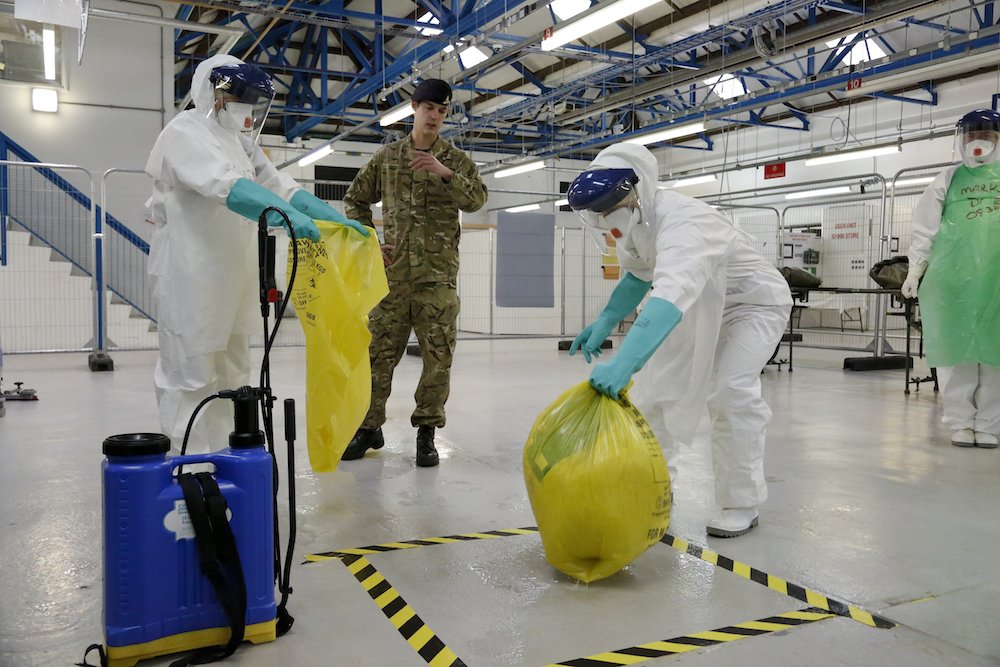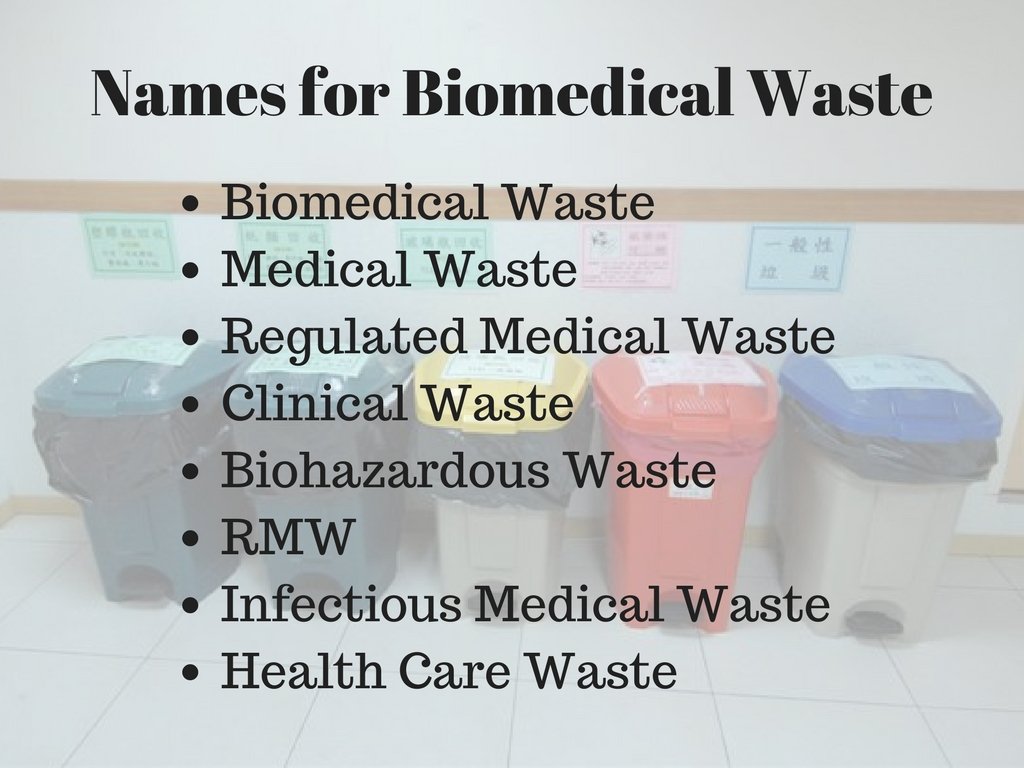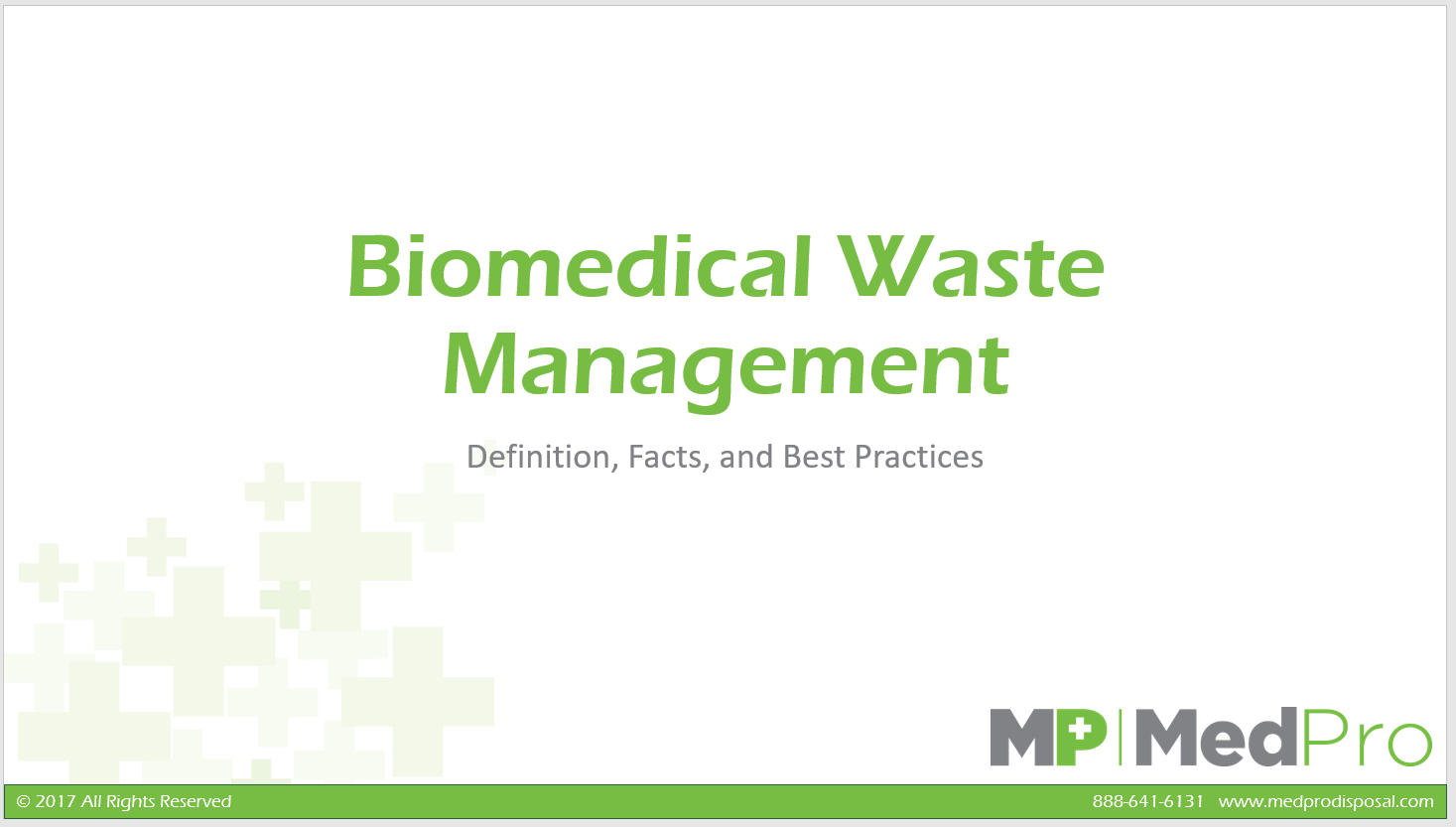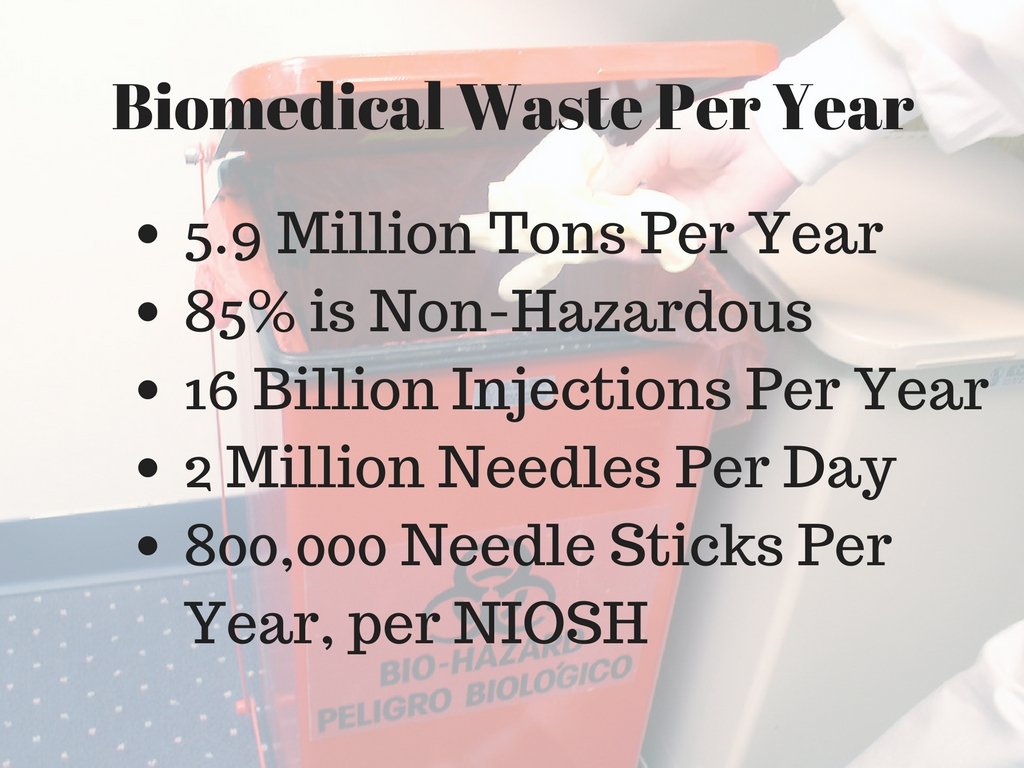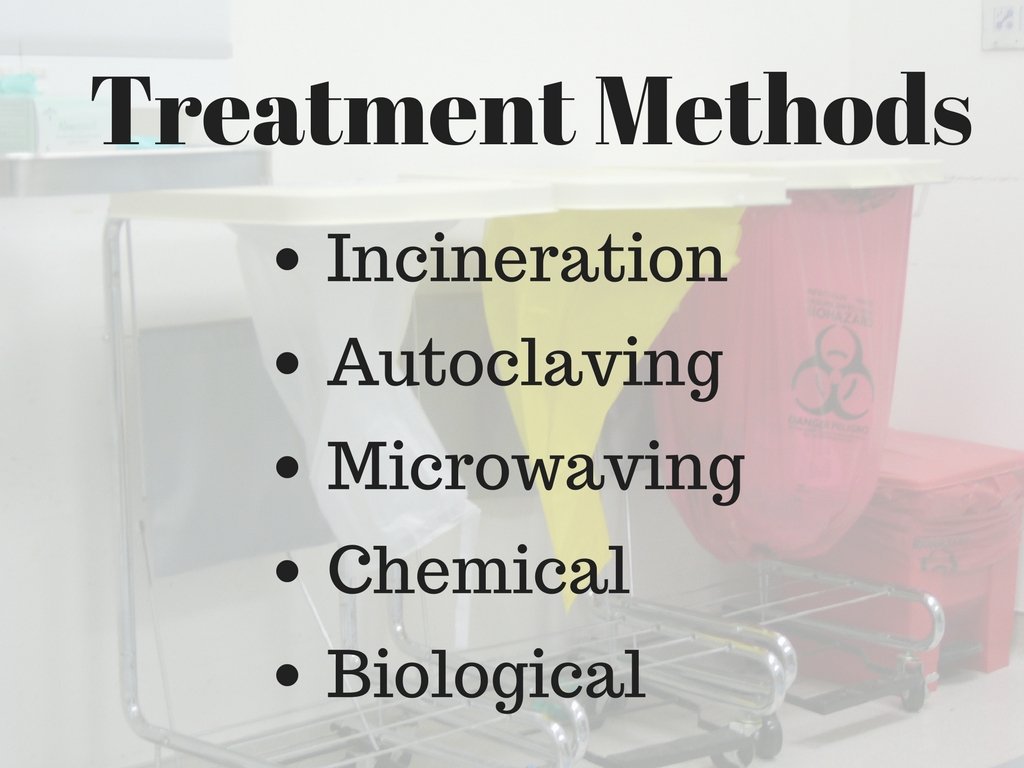Biomedical waste management is a crucial part of any health care facility’s daily operation. With over 800,000 needle sticks per year and 1.34 million pounds of medical waste each hour in the U.S., correct biomedical waste disposal is a key concern in any medical business. Because we at MedPro Waste Disposal help providers maximize health care success, we’ve developed this biomedical waste PPT and guide.
Just looking for the PowerPoint deck on bio medical waste? Click here.
Definition of Biomedical Waste
The definition of biomedical waste is “Any waste containing infectious (or potentially infectious) material.” That definition can include contaminated waste generated by various health care facilities. Generators of biomedical waste include doctor’s offices, hospitals, laboratories, dental practices, funeral homes, veterinary clinics, or research facilities.
The 1988 Medical Waste Tracking Act’s definition of biomedical waste (or “bio medical waste”) includes waste generated during medical treatment, diagnosis, immunization, or research involving human beings or animals. Waste can consist of bodily fluids, human body parts or tissues, sharps like needles, scalpels or broken glass, culture dishes, gloves, bandages, and swabs.
Different Names for Biomedical Waste
Biomedical waste or bio medical waste goes by many different names. They all have the same general definition, but biomedical waste refers specifically to any waste that’s potentially contaminated with disease-causing infecious agents.
- Biomedical Waste
- Medical Waste
- Regulated Medical Waste (RMW)
- Clinical Waste
- Biohazardous Waste
- Infectious Medical Waste
- Health Care Waste
The term “biomedical waste” doesn’t technically include all types of waste generated by health care facilities like pharmaceutical waste or radioactive waste. That said, the term is often used comprehensively.
The WHO classifies human tissue, fluids, body parts, sharps, and contaminated supplies specifically as biohazardous. The WHO considers animal tissue and non-contaminated waste “general medical waste.”
Strange but true, a dustpan full of dirt from a break-room floor, a bin of recyclable office paper, and a trash can full of coffee grounds and eggshells are all technically “medical waste,” provided they come from a health care facility. This kind of “medical waste” is non-regulated and not consider “biomedical.”
Biomedical Waste Management PPT Deck
Download a Biomedical Waste Management PPT (Powerpoint Deck) right here. The deck is in .pptx format, not .ppt. (PPTX is the modern version of PPT, for Office 2007 and beyond. It features much smaller file size and better compatibility across different machines and platforms.) We call it a “PPT” because that’s the way most people search for it. The biomedical waste management PPT here deck covers everything in this post, including:
- Biomedical Waste Definition
- Names for Biomedical Waste
- Types of Biomedical Waste
- Non-Biological Hazardous Waste
- How Much is Generated Each Year
- Brief History of Biomedical Waste
- Regulated vs Unregulated
- Risks
- Treatment Methods
- Biomedical Waste Best Practices
- Color Coding
- Who Generates Biomedical Waste
- Links to Additional Resources
Find Out How Much You Can Save Instantly.
Try our on-line savings calculator.
Biomedical Waste Types
The term “biomedical waste” often gets used interchangeably with other terms. However, it technically refers only to those items potentially contaminated with infectious agents. The list below shares the most common medical waste categories, as identified by the WHO. Biomedical waste is a subset of the whole.
Biomedical Waste
- Sharps. This kind of biomedical waste covers anything that might pierce the skin. That includes needles, broken glass, lancets, scalpels, trocars, wires, ampules, and razors.
- Pathological Waste. Human tissue, blood, fluids, body parts, or contaminated carcasses fall into this biomedical waste category.
- Infectious Waste. This group includes anything potentially infectious. That includes swabs, equipment, excreta, and lab cultures.
Non-Biomedical Hazardous Waste
- Pharmaceutical Waste. This type of non-biomedical waste covers unused drugs and vaccines, including expired pills, injectables, and antibiotics.
- Radioactive Waste. This non-biomedical but still hazardous waste category refers to unused lab research liquid or radiotherapy liquid. It may also mean glassware or supplies contaminated with such liquids.
- Chemical Waste. This may include solvents, disinfectants, batteries, and heavy metals from medical equipment (i.e. mercury from broken thermometers).
- Genotoxic Waste. This highly hazardous non-biomedical waste may be mutagenic, carcinogenic, or teratogenic. It can include certain cytotoxic cancer-treatment drugs.
Non-Regulated Medical Waste
Non-regulated waste like floor sweepings or food waste from health care facilities is still termed “medical waste,” but not “biomedical.” It’s disposed of in the regular trash. It figures heavily in biomedical waste discussions because staff often accidentally dispose of it in hazardous waste containers, driving up costs.
How Much Biomedical Waste Per Year?
This list shows the helicopter view of medical waste generation in the U.S., including amount, breakdown, and hazards.
Amount. Health care facilities in the U.S. generate about 5.9 million tons of biomedical waste and other waste each year. That’s 32 lbs per staffed bed each day. That’s a great fact, but it’s a little skewed. It comes from 11.8 billion pounds per year, divided by one million staffed beds in the U.S. Of course not all medical waste comes from staffed beds or even hospitals. In reality, each bed itself creates about a pound of waste per day in wealthy countries, according to the WHO.
Breakdown. 85% of medical waste is non-hazardous. That leaves about a million tons per year of biomedical waste and other hazardous medical waste. That’s two billion pounds per year, or 5.5 million pounds of bio hazardous waste per day.
Danger. Biomedical waste includes the refuse from 16 billion injections every year. That’s 43 million injections each year, or 2 million needles a day in the U.S. alone. Those 730 million annual needles in the U.S. produce 800,000 accidental needle sticks. That’s about one needle stick for every 900 needles used. Body fluids, body parts, tissues, equipment, dressings, and swabs can also carry disease to health care workers and the public at large.
A Brief History of Biomedical Waste
Biomedical waste management in the U.S. has evolved significantly in the past few decades. In the 1980’s, a series of highly publicized incidents of medical waste washing up on beaches caused a public outcry. The resulting regulatory push created the 1988 Federal Medical Waste Tracking Act.
The FMWT Act introduced strict waste transportation rules for hospitals and other health care facilities. The act expired in 1991, but lessons learned were passed to state agencies, which assumed the regulatory burden.
New biomedical waste management solutions continue to emerge, including improvements to safety, cost, convenience, and speed. Some of the most effective advancements come from a handful of new waste disposal firms that manage biomedical waste via the U.S. mail.
The Risk to Human Health
The figure of 32 lbs per day of medical waste per hospital bed is very real. Nearly 5 lbs per day of that amount is regulated biomedical waste or other hazardous material. Multiplied by a million staffed beds in the U.S., that’s 5 million pounds each and every day, or 208,000 pounds per hour.
The sheer volume of biomedical waste creates literally millions of opportunities per day for infectious agents to harm health care workers, patients, waste workers, and the public at large. Needle sticks are common, occurring at a rate of 91 per hour in the U.S. alone. Non-needle hazardous waste can cause infection by exposing us to dangerous bacteria and viruses. That happens when we come into direct contact with contaminated material or drink water polluted by it.
Biomedical Waste Management: On-Site vs Off-Site
When planning for effective biomedical waste management, the first question becomes, “Where does biomedical waste get treated?” There are two potential answers: on-site or off-site. The second question is, “How does the waste get treated?”
On-Site Waste Management
On-site biomedical waste management can work well for large, well-funded health care facilities. The equipment involved is generally very expensive to buy, maintain, and run. Strict regulations around the operation of this machinery can also prohibit entry.
Off-Site Waste Management
For smaller facilities and private practices, off-site biomedical waste management presents a budget-friendly option. Medical waste collection firms own and maintain the treatment equipment. Some carry comprehensive insurance policies to protect their clients. They also ensure proper training and regulatory compliance. These vendors either collect the waste by mail or truck.
- Mailback Services use the U.S. mail to transfer waste securely to a treatment facility. This method is the most budget-friendly. Vendors must have experience and training in industry best practices and regulatory compliance.
- Truck Services involve signing a contract with a licensed biomedical waste disposal vendor that collects the waste for treatment. Waste is shipped to a disposal facility in specialized containers.
Five Biomedical Waste Management Options
Whether biomedical waste management happens on-site or off-site, there are five basic methods for processing. Incineration is still the only method for treating pathological medical waste. Other wastes are increasingly managed by autoclaving or microwaving. In some cases, chemical treatment is appropriate. Biological waste treatment using enzymes is still in the experimental phase.
Incineration. This was the method of choice for biomedical waste management in the 1990’s and before. New EPA regulations have caused a shift to other methods, but it’s still the only way to treat pathological waste like human tissue, blood, or body parts.
Autoclave. Non-pathological waste can be rendered non-infectious through steam-sterilization. Afterward, it can be taken to landfills as regular non-biomedical waste.
Microwave. High-powered microwaves can neutralize non-pathological biomedical waste for disposal in solid waste landfills.
Chemical. This method is largely reserved for treating chemical medical waste.
Biological. An experimental method treats some biomedical waste with enzymes, though it’s still in the developmental phase.
Best Practices for Biomedical Waste Management
Following the best practices for biomedical waste management is a must for avoiding regulatory action and lowering costs. Health care facilities and their employees must know the laws in their areas. Proper sorting, color-coding, containering, and documentation are all essential.
- Start by knowing the biomedical waste management laws. The DOT, EPA, OSHA, DEA, and state and local agencies all carry their own health care waste regulations. Know the laws, or hire a vendor who knows them back to front.
- Separate biomedical waste from non-hazardous medical waste. Train staff not to put non-regulated waste into bio hazard bags and containers, since this causes overspending.
- Sort medical waste by type. Waste should be sorted into biomedical waste (pathological, infectious, sharps), radioactive, chemical, pharmaceutical, and non-hazardous.
- Color-code all biomedical waste. Biohazard waste should go in red biohazard bags and containers. Sharps go into puncture-resistant red biohazard containers. Hazardous pharmaceutical waste goes in black containers, while non-hazardous pharma waste goes in blue containers. Shielded containers marked with radioactive symbols are for radioactive wastes like Iodine-131 or Fluorine-18. Trace chemo wastes go into yellow containers.
- Use the right containers. Some medical waste can be put in special cardboard boxes. Other waste can go in special tubs. Still other waste gets locked up for storage and transit.
- Prepare containers correctly. Biomedical waste bags and containers must be taped before shipping. They must then be packaged per DOT weight guidelines. All waste should be stored in a dry, secure area, and labeled properly for transport or shipping.
- Document all biomedical waste properly. Correct documentation protects both the waste disposal company and the provider. Each bag and container must travel with the right paperwork throughout its journey.
- Hire a trusted biomedical waste disposal company. With a forest of regulations, hazards, and liability, the right partner can make all the difference. Choose a reliable vendor with predictable rates and a long history of compliance.
Who Regulates Biomedical Waste?
Biomedical waste management was regulated by the EPA throughout the 1980’s. Now, most regulation has passed on to the states. To learn who governs medical waste in your area, see the EPA local list in the “Resources” section below.
Apart from state and local agencies, several federal bodies also govern biohazardous medical waste management. These include the Department of Transportation (DOT), the Centers for Disease Control (CDC), the Occupational Safety and Health Administration (OSHA), and the U.S. Food and Drug Administration (FDA).
Who Creates Biomedical Waste?
Biomedical waste generators can include almost any health care source, including some non-health care entities with health care components. (For example, a hotel near a hospital where patients stay briefly before returning home.)
This list of waste-generators includes everything from private practices to hospitals, labs, prisons, and commercial offices.
- Private Practices
- Dental Offices
- Veterinary Offices
- Urgent Care Clinics
- Nursing Homes
- Prisons
- Funeral Homes
- Retail Health Clinics
- Medical Research Labs
- Hospitals
- Home Health Care / Home Infusion
- Hotels
- Commercial Buildings / Offices
Biomedical Waste Resources
Use the kit below for further biomedical waste info needs. The EPA Resource List makes a great starting place for learning all the regulations in your area. The WHO manual offers a comprehensive instruction into medical waste best practices.
This EPA Resource List provides an excellent collection of links to local and state environmental bodies and biomedical waste programs nationwide.
The WHO offers this free 300+ page manual on health care waste management. The book includes everything from general info, like the definition of biomedical waste, to specific action items, like reuse and collection methods.
This EPA publication is packed with great sharps disposal ideas and tools. It covers the dangers of sharps, plus disposal options, facts, and links to various local and state programs.
MedPro Waste Disposal offers low-cost, 100% compliant pickup, transportation, and treatment of regulated biomedical waste, including sharps and pathological waste. MedPro also handles pharmaceuticals and other waste. They’ve also got a versatile mail back sharps container service and comprehensive compliance training.
See this Waste Savings Calculator to learn how much your practice can save with a fully compliant biomedical waste disposal vendor like MedPro Waste Disposal. They offer predictable low rates with dependable high-quality service.
Conclusion
Biomedical waste is a subset of medical waste at large. It includes sharps and pathological or infectious waste. It can encompass anything from needles to broken glass to human tissues and fluids to swabs and bandages. It’s basically anything potentially contaminated with infectious material.
The complete guide above gives the definition of biomedical waste, plus types, best practices, disposal methods, and regulating agencies. There’s even a downloadable biomedical waste powerpoint deck you can grab and customize to your needs.
Got a comment or question? Give us a shout in the comments section below!
